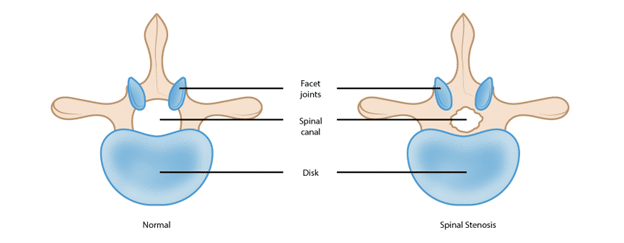Lumbar Spine Stenosis

Lumbar spinal stenosis narrows the spinal canal in the lower back, squeezing the spinal cord and nerves. Constriction can lead to leg discomfort, numbness, and weakness. Lumbar spinal stenosis increases with age, particularly in the elderly. Understanding the causes and therapies is critical since they can impact mobility and quality of life.
Symptoms of Lumbar Spinal Stenosis
Common symptoms of lumbar spinal stenosis include:
Lower Back discomfort: Many patients have ongoing lower back discomfort, which might increase with extended standing or walking.
Leg discomfort or Cramping: Patients frequently experience discomfort radiating down one or both legs, which is sometimes described as cramping or a burning sensation. This soreness may worsen with activities but improve with rest.
Numbness and Tingling: Affected people may suffer numbness or tingling sensations in their legs or feet, which might disrupt their regular routines.
Weakness: Some patients may experience leg weakness, making it difficult to walk or stay balanced.
Postural Relief: Bending forward or sitting down can help alleviate symptoms by relieving pressure on the spinal nerves.
Causes of Lumbar Spinal Stenosis
Several factors can contribute to the development of lumbar spinal stenosis:
Degenerative changes: The most common cause is age-related wear and tear on the spine. Osteoarthritis, for example, can cause bone spurs and ligament thickening, resulting in a narrower spinal canal.
Congenital Factors: Some people are born with a naturally narrow spinal canal, which can predispose them to stenosis later in life.
Injuries: Traumatic spinal injuries can cause structural alterations that lead to constriction.
Spondylolisthesis: It is a disorder in which one vertebra slips forward over another, squeezing surrounding nerves and contributing to stenosis.
Non-Surgical Treatment for Lumbar Spinal Stenosis
For many patients with lumbar spinal stenosis, non-surgical treatment options can provide relief from symptoms:
- Medications: Non-steroidal anti-inflammatory drugs (NSAIDs) are commonly prescribed to help alleviate pain and reduce inflammation. In some cases, oral corticosteroids may also be used for short-term relief.
- Activity Modification: Patients are often advised to avoid activities that exacerbate their symptoms. Incorporating rest periods during activities can help manage discomfort.
- Epidural Steroid Injections: Injecting anti-inflammatory medicine directly into the epidural area around the spinal nerves relieves pain and inflammation temporarily.
Surgical Treatment for Lumbar Spinal Stenosis
Surgical treatment may be considered if non-surgical treatments are ineffective or if symptoms significantly impede daily activities.
Laminectomy: This procedure entails the removal of a portion of the vertebra (the lamina) to increase the space available for the spinal cord and nerves. Lumbar spinal stenosis is frequently treated with this surgical procedure.
Spinal Fusion: In the event of instability, spinal fusion may be implemented concurrently with laminectomy. This surgery involves the fusion of two or more vertebrae to stabilize the spine.
Foraminotomy: This procedure expands the foramina, which are the openings through which nerves depart the spine, thereby alleviating pressure on compressed nerves.
Conclusion
Lumbar spinal stenosis is a common ailment that can result in considerable pain and functional impairments if not addressed. Comprehending its symptoms, etiologies, and accessible therapeutic modalities is essential for optimal therapy. Although non-surgical treatments frequently offer comfort to several sufferers, surgical alternatives exist for individuals who do not sufficiently respond to conservative approaches.
For enquiries and online appointments: Email – Naveen.st@gmail.com
Call/Whatsapp – +91 7676090119
Or send an enquiry through the website www.NaveenSpine.com/contact




